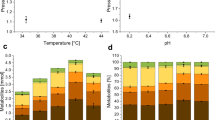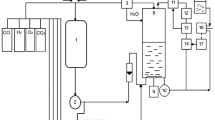Abstract
Fermentation of glucose influences CO2 assimilation to acetate in homoacetogens. Blautia coccoides was investigated for a better understanding of the metabolic characteristics of homoacetogens in mixotrophic cultures. Batch cultures of the strain with H2/CO2 as a sole carbon source reached an acetate yield of 5.32 g/g dry cell weight after 240 h of incubation. Autotrophic metabolism was inhibited as glucose was added into the culture: the higher the glucose concentration the lower the autotrophic ability of the bacterium. Autotrophy was inhibited by high glucose concentration, probably due to the competition for coenzyme A between the Embden-Meyerhof-Parnas pathway and the Wood-Ljungdahl carbon fixation pathway, the energy (adenosine triphosphate) allocation for synthesis of cell carbon and reduction of CO2, in combination with the low pH caused by the accumulation of acetate.




Similar content being viewed by others
References
Bernalier A, Lelait M, Rochet V, Grivet JP, Gibson GR, Durand M (1996) Acetogenesis from H2 and CO2 by methane and non-methane-producing human colonic bacterial communities. FEMS Microbiol Ecol 19:193–202
Braun K, Gottschalk G (1981) Effect of molecular-hydrogen and carbon-dioxide on chemo-organotrophic growth of Acetobacterium woodii and Clostridium aceticum. Arch Microbiol 128:294–298
Cord-Ruwisch R, Seitz H-J, Conrad R (1988) The capacity of hydrogenotrophic anaerobic bacteria to compete for traces of hydrogen depends on the redox potential of the terminal electron acceptor. Arch Microbiol 149:350–357
Daniell J, Köpke M, Simpson SD (2012) Commercial biomass syngas fermentation. Energies 5:5372–5417
Diekert G (1990) CO2 reduction to acetate in anaerobic bacteria. FEMS Microbiol Lett 87:391–395
Diekert G, Wohlfarth G (1994) Metabolism of homoacetogens. Antonie Van Leeuwenhoek 66:209–221
Drake HL, Gößner AS, Daniel SL (2008) Old acetogens, new light. Ann N Y Acad Sci 1125:100–128
Fast AG, Schmidt ED, Jones SW, Tracy BP (2015) Acetogenic mixotrophy: novel options for yield improvement in biofuels and biochemicals production. Curr Opin Biotech 33:60–72
Fuchs G (2011) Alternative pathways of carbon dioxide fixation: insights into the early evolution of life? Annu Rev Microbiol 65:631–658
Kamlage B, Gruhl B, Blaut M (1997) Isolation and characterization of two new homoacetogenic hydrogen-utilizing bacteria from the human intestinal tract that are closely related to Clostridium coccoides. Appl Environ Microb 63:1732–1738
Kaneuchi C, Benno Y, Mitsuoka T (1976) Clostridium coccoides, a new species from the feces of mice. Int J Syst Bacteriol 26:482–486
Kotsyurbenko OR, Glagolev MV, Nozhevnikova AN, Conrad R (2001) Competition between homoacetogenic bacteria and methanogenic archaea for hydrogen at low temperature. FEMS Microbiol Ecol 38:153–159
Latif H, Zeidan AA, Nielsen AT, Zengler K (2014) Trash to treasure: production of biofuels and commodity chemicals via syngas fermenting microorganisms. Curr Opin Biotech 27:79–87
Leang C, Ueki T, Nevin KP, Lovley DR (2013) A genetic system for Clostridium ljungdahlii: a chassis for autotrophic production of biocommodities and a model homoacetogen. Appl Environ Microbiol 79:1102–1109
Li J, Lijian Y, Liu C, Ban Q (2013) Homoacetogenic strain CA3 and its optimization condition for acetate yield from glucose by fermentation. Science and Technology Review (in Chinese) 31:20–24
Li J, Ren N, Li B, Qin Z, He J (2008) Anaerobic biohydrogen production from monosaccharides by a mixed microbial community culture. Bioresource Technol 99:6528–6537
Luo G, Karakashev D, Xie L, Zhou Q, Angelidaki I (2011) Long-term effect of inoculum pretreatment on fermentative hydrogen production by repeated batch cultivations: homoacetogenesis and methanogenesis as competitors to hydrogen production. Biotechnol Bioeng 108(8):1816–1827
Müller V (2003) Energy conservation in acetogenic bacteria. Appl Environ Microb 69:6345–6353
Nie Y, Liu H, Du G, Chen J (2008) Acetate yield increased by gas circulation and fed-batch fermentation in a novel syntrophic acetogenesis and homoacetogenesis coupling system. Bioresource Technol 99:2989–2995
Loubière Pascal, Gros Evelyne, Paquet Veronique, Lindley Nicholas D (1992) Kinetics and physiological implications of the growth behaviour of Eubacterium limosum on glucose/methanol mixtures. J Gen Microbiol 138:979–985
Ragsdale SW, Pierce E (2008) Acetogenesis and the Wood-Ljungdahl pathway of CO2 fixation. Biochim Biophys Acta 1784:1873–1898
Kellum Rebecca, Drake Harold L (1984) Effects of cultivation gas phase on hydrogenase of the acetogen Clostridium thermoaceticum. J Bacteriol 60(1):466–469
Rice EW, Bridgewater L, Association APH (2012) Standard methods for the examination of water and wastewater. American Public Health Association Washington, DC
Rieu Lesme F, Morvan B, Collins M, Fonty G, Willems A (1996) A new H2/CO2 using acetogenic bacterium from the rumen: description of Ruminococcus schinkii sp. nov. FEMS Microbiol Lett 140:281–286
Saady NMC (2013) Homoacetogenesis during hydrogen production by mixed cultures dark fermentation: unresolved challenge. Int J Hydrogen Energ 38:13172–13191
Schiel Bengelsdorf B, Dürre P (2012) Pathway engineering and synthetic biology using acetogens. FEBS Lett 586:2191–2198
Siriwongrungson V, Zeng RJ, Angelidaki I (2007) Homoacetogenesis as the alternative pathway for H2 sink during thermophilic anaerobic degradation of butyrate under suppressed methanogenesis. Water Res 41:4204–4210
Daniel Steven L, Drake Harold L (1993) Oxalate and glyoxylate dependent growth and acetogenesis by Clostnidium thermoaceticum. Appl Environ Microb 55(9):3062–3069
Miller Terry L, Wolin Meyer J (1995) Bioconversion of dellulose to acetate with pure cultures of Ruminococcus albus and a hydrogen-using acetogen. Appl Environ Microb 61(11):3832–3835
Acknowledgments
This work was supported financially by National Natural Science Foundation of China (Grant No. 51178136), and the State Key Laboratory of Urban Water Resource and Environment, Harbin Institute of Technology (Grant No. 2013DX11).
Author information
Authors and Affiliations
Corresponding author
Ethics declarations
Conflict of interest
The authors declare that they have no conflict of interest.
Human participants
This article does not contain any studies with human participants performed by any of the authors.
Informed consent
Informed consent was obtained from all individual participants included in the study.
Rights and permissions
About this article
Cite this article
Liu, C., Li, J., Zhang, Y. et al. Influence of glucose fermentation on CO2 assimilation to acetate in homoacetogen Blautia coccoides GA-1. J Ind Microbiol Biotechnol 42, 1217–1224 (2015). https://doi.org/10.1007/s10295-015-1646-1
Received:
Accepted:
Published:
Issue Date:
DOI: https://doi.org/10.1007/s10295-015-1646-1




